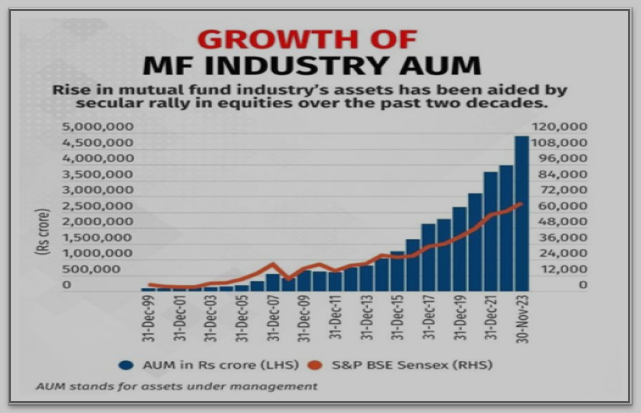Investing money is a crucial aspect of financial planning that involves allocating resources with the expectation of generating future returns. Unlike saving, which involves setting aside money in a secure and accessible manner, investing involves taking calculated risks to achieve higher returns. The importance of investing cannot be overstated, as it allows individuals to build wealth, achieve financial independence, and secure their future. However, for many, investing can be a complicated and daunting endeavour. With an overwhelming array of options, many people are unsure where to start. One of the most accessible and popular investment vehicles is the mutual fund. This blog will explore what mutual funds are, why you should consider investing in them, and how earnings are calculated. We'll also provide practical examples to illustrate these concepts.
A mutual fund is an investment vehicle that collects money from numerous investors to buy a diverse portfolio of securities, including stocks, bonds, money market instruments, and other assets. Professional money managers operate these funds, aiming to meet the fund's investment objectives. Each investor owns shares in the mutual fund, which represent a portion of its holdings.
Example
Imagine you and nine friends each have $100 to invest. Instead of individually purchasing stocks or bonds, you all pool your money together, creating a $1,000 fund. You then hire a professional manager to invest this money in a diversified portfolio of securities. Each of you owns a share of this collective investment, meaning you each have a 10% stake in the mutual fund.

There are various types of mutual funds, each with specific investment objectives:
Equity Funds: Invest primarily in stocks and offer the potential for high returns but come with higher risk due to market volatility.
Fixed income Fund/Bond Funds: They focus on investing in government and corporate bonds. They provide regular income with lower risk compared to equity funds.
Money Market Funds: They invest in short-term, low-risk securities and offer low high liquidity.
Balanced Funds: Invest in a mix of stocks and bonds to balance risk and return.
Index Funds: Aim to replicate the performance of a specific market index.
Sector Funds: Focus on specific sectors of the economy, like technology or healthcare. They have higher risk.
Individuals have different financial objectives, such as funding for college or marriage, buying a home, or covering post-retirement expenditures. Consequently, the investment products needed to reach these goals also differ. Compared to investing in individual assets, mutual funds provide a number of advantages that make them an attractive investment option for both novice and experienced investors.
Diversification:
Diversification is a strategy that entails distributing investments among different assets to minimize risk. Mutual funds inherently provide diversification because they invest in a wide range of securities. This reduces the impact of poor performance by any single investment on the overall portfolio.
Professional Management:
Mutual funds are managed by professional fund managers who have the expertise and resources to research and select investments. This professional management can be especially beneficial for individuals who lack the time or knowledge to manage their investments effectively.
Liquidity:
Mutual fund shares can be bought or sold on any business day, providing investors with a high degree of liquidity. This means you can easily convert your investment into cash if needed.
Affordabilit:
Mutual funds allow investors to pool their money, making it possible to invest in a diversified portfolio with a relatively small amount of capital. This is particularly advantageous for individual investors who might not have enough money to achieve diversification on their own.
Convenience:
Investing in mutual funds is straightforward and requires minimal effort from the investor. Most funds offer automatic investment and withdrawal options, making it easy to manage your investment.
Example: Consider Emma, a 30-year-old professional who wants to start investing for her future but doesn't have the time to manage a portfolio actively. She decides to invest in a mutual fund that aligns with her long-term financial goals. By doing so, she gains access to a diversified portfolio managed by professionals, allowing her to focus on her career while her investment grows over time.
Earnings from mutual funds come from three primary sources: dividends, interest, and capital gains.
Dividends :
When the mutual fund receives dividends from the stocks in its portfolio, it distributes these dividends to its shareholders. For instance, if the fund holds shares in a company that pays dividends, the fund collects these payments and passes them on to investors.
Interest :
Mutual funds that invest in bonds or other debt instruments earn interest from these securities. This interest income is also distributed to shareholders.
Capital Gains :
When the fund sells securities that have appreciated in value, it realizes a capital gain. These gains are distributed to shareholders, typically at the end of the year.
The value of a mutual fund is measured by its Net Asset Value (NAV). NAV is calculated by dividing the total value of the fund’s assets by the number of outstanding shares. The NAV per share changes daily based on the performance of the fund’s investments.
Let’s assume a mutual fund has the following earnings over a year:
Dividends: RS 10,000
Interest: RS 5,000
Capital Gains: RS 15,000
The fund has 10,000 shares outstanding. To calculate the earnings per share (EPS):
Total Earnings = Dividends + Interest + Capital Gains = Rs 10,000 + Rs 5,000 + Rs 15,000 = Rs 30,000
Earnings Per Share = Total Earnings / Number of Shares = Rs 30,000 / 10,000 = Rs 3 per share
If the NAV of the fund was Rs 50 at the beginning of the year, and assuming the NAV increase is solely due to the earnings, the new NAV at the end of the year would be Rs 53.
Investing in mutual funds involves various risks, some of which are inherent to the nature of the investments held by the fund, while others are related to broader market conditions or the structure of the fund itself. Understanding these risks is crucial for making informed investment decisions. Here are some key risks associated with mutual funds:
Market Risk: The risk of investments declining due to market conditions.
Interest Rate Risk: The risk of bond prices falling due to rising interest rates.
Credit Risk: The risk of bond issuers defaulting on payments.
Inflation Risk: The risk that returns won’t keep pace with inflation, eroding purchasing power.
Liquidity Risk: The risk of not being able to quickly sell investments without significant price reductions.
Manager Risk: The risk of poor investment decisions by the fund manager.
Currency Risk: The risk of exchange rate fluctuations affecting international investments.
Sector Risk: The risk of poor performance in a specific industry impacting the fund.
Reinvestment Risk: The risk of reinvesting returns at lower rates than the original investments.
Performance Risk: The risk of the fund not achieving its investment objectives.
Expense Risk: The risk of high fees and expenses reducing net returns.
Understanding these risks helps investors make informed decisions and choose mutual funds that align with their financial goals and risk tolerance.
Mutual funds are an excellent investment vehicle for individuals looking to diversify their investments, benefit from professional management, and enjoy the convenience and affordability they offer. By understanding how mutual funds work and how earnings are calculated, you can make informed decisions and choose funds that align with your financial goals.
Whether you are a novice investor or have years of experience, mutual funds can play a crucial role in building a balanced and robust investment portfolio. By investing in mutual funds, you can leverage the expertise of professional managers and gain exposure to a diversified range of assets, helping you achieve your long-term financial objectives.
